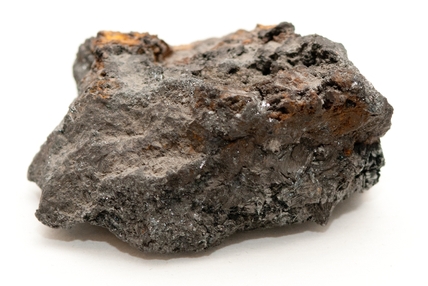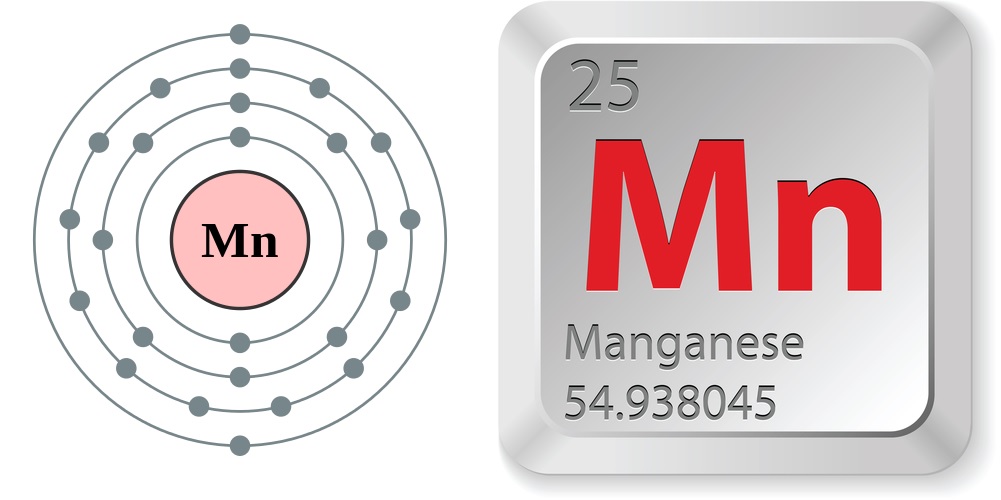Facts About Manganese (original) (raw)

Pyrolusite (manganese dioxide) is one of the most common manganese minerals. (Image credit: Shutterstock)
Manganese is a very hard, brittle, gray-white transition metal that is naturally found in a variety of minerals, but never on its own. Manganese is one of the most common elements in Earth's crust and is widely distributed across the planet's surface.
Manganese is vital to human and animal life in metabolic functions. Many alloys containing manganese are used in steel production, glass making, and even to make the aluminum in soda cans thinner and stronger.
Just the facts
- Atomic number (number of protons in the nucleus): 25
- Atomic symbol (on the Periodic Table of Elements): Mn
- Atomic weight (average mass of the atom): 54.938
- Density: 4.29 ounces per cubic inch (7.43 grams per cubic cm)
- Phase at room temperature: Solid
- Melting point: 2,282 degrees Fahrenheit (1,250 degrees Celsius)
- Boiling point: 3,740 F (2,060 C)
- Number of natural isotopes (atoms of the same element with a different number of neutrons): 1. There are also 21 very short-lived radioactive or artificial isotopes with extremely short half-lives.
- Most common isotopes: Mn-55 (100 percent of natural abundance)

(Image credit: Greg Robson/Creative Commons, Andrei Marincas Shutterstock)
History
Manganese has been used since ancient times, science writer John Emsley wrote in an article in Nature Chemistry. Cave artists in France used the black ore (manganese dioxide or pyrolusite) at least 30,000 years ago. Pliny the Elder, a Roman philosopher, wrote in the first century A.D. that it was also used in glass making to make the glass clear and as a black pigment in pottery.
In 1740, Johann Heinrich Pott, a German chemist, observed that pyrolusite contained a new earth metal, rather than iron as was commonly believed, according to Chemicool, and Ignatius Gottfried Kaim, an Austrian chemist, first isolated manganese in 1770. The isolated metal was impure, and several attempts to purify manganese failed. Johan Gottlieb Gahn, a Swedish chemist, came close in 1774 when he produced a white, hard, brittle metal.
Who knew?
- Manganese is a transition metal, according to Chemicool. Transition metals are ductile, malleable and conduct electricity and heat.
- According to the Los Alamos National Laboratory, the word manganese comes from the Latin word for magnets, "magnes." Manganese, however, by itself is not magnetic. When combined with aluminum, antimony and copper, the resulting alloys are highly ferromagnetic.
- Pure manganese is reactive, burns in oxygen, rusts in water and dissolves in dilute acids, according to Lenntech.
- Manganese is very abundant in soils, occurring in both oxides and hydroxides, according to Lenntech.
- According to the Royal Society of Chemistry, manganese is the fifth most abundant metal in Earth's crust.
- Manganese is essential to photosynthesis and is used to create oxygen, according to Chemicool.
- It was discovered that manganese is vital to human lives in the 1950s, according to Emsley, in an article published in Nature.
- Manganese is essential to metabolic functions, according to Chemicool. Human bodies contain approximately 10 to 20 milligrams, and because it can't be stored, humans need to constantly replenish the supply through diet.
- Some of the foods that contain the highest concentrations of manganese include spinach, tea, some herbs, grains, rice, soybeans, eggs, nuts, olive oil, green beans and oysters, according to Lenntech.
- Manganese is primarily found in the bones, liver, kidneys, and pancreas, according to the University of Maryland Medical Center, and helps the body form connective tissue, bones, blood-clotting factors, and sex hormones.
- According to Lenntech, manganese is essential not only to humans, but also to all species. Some species can store and accumulate manganese including diatoms, mollusks and sponges.
- Too much manganese, however, can be toxic. According to Lenntech, symptoms can include hallucinations, forgetfulness, nerve damage, dullness, weak muscles, headaches and insomnia. It can also cause Parkinson's disease, lung embolisms, bronchitis, impotence in men and schizophrenia.
- Too little manganese can cause obesity, glucose intolerance, blood clotting, skin conditions, low cholesterol levels, skeletal disorders, neurological symptoms and even hair color changes, according to Lenntech.
- According to the University of Maryland Medical Center, manganese may be beneficial in treating osteoporosis, arthritis, premenstrual syndrome, diabetes and epilepsy.
- Because it is brittle by itself, manganese is primarily used in alloys, according to the Royal Society of Chemistry.
- Manganese is used to make clear glass, to desulfurize and deoxidize steel in steel production and to reduce the octane rating in gasoline. It also is used as a black-brown pigment in paint and as filler in dry cell batteries. Its alloys help stiffen the aluminum in soft-drink cans, according to Chemicool.
- The purple color of amethysts is caused by manganese, according to the Jefferson Laboratory.
- The lack of manganese in sedimentary rocks dating between 400 and 1,800 million years ago indicates that oxygen levels in the ocean were low, according to John Emsley.
- Manganese is primarily mined in China, Africa, Australia and Gabon, according to the Royal Society of Chemistry. The metal is commonly found in oxides and is separated by being reduced with sodium, magnesium or aluminum or by electrolysis.
- At least 25 million tons of manganese ores are mined annually, according to Lenntech.
- Approximately 85 to 90 percent of mined manganese is used in steelmaking, according to the United States Geological Survey.
Current research
One major research area involving manganese is in health. It is known that manganese is essential for human systems to function properly and too much is bad for you. Much research is being done investigating exposure to an excess of manganese.
One set of studies focuses on researching a potential link between manganese exposure in children and their intellectual function. A study by a group of researchers in the United States and Bangladesh published in 2011 in NeuroToxicology by Wasserman, et al. expanded upon a previous study that only studied the effects of arsenic on children. The researchers tested levels of manganese in 299 children between the ages of 8 and 11. The study found that there is a significant link between a variety of manganese markers and perceptual reasoning and memory skills.
Several additional studies following up on the previous one were published in subsequent years, including one published in Environmental Health Perspectives in 2015 by Wasserman, et al. with about 300 10-year-old children. Another one, published in Environmental Health in 2016 by Rodrigues, et al., studied over 500 children that were 2 to 3 years old. Both studies involved teams of scientists from the United States and Bangladesh working with Bangladeshi children. Blood samples were taken in both studies and levels of manganese and arsenic were measured (as well as lead in the second study). As with the 2011 study, researchers found that that reduced levels of manganese (as well as arsenic and lead) in the drinking water showed increased working memory and other cognitive functions. Continued research will be conducted to determine longer-term effects of high levels of manganese exposure in the intelligence of children.
Another study published in Environmental Health Perspectives by Rohman, et al., a group of scientists from Sweden and Bangladesh, performed a similar study focusing on behavior as well as cognitive abilities in 10-year-old Bangladeshi children. The study tested a group of children from the time the mothers were pregnant until they were 10, and increased exposure to manganese early in life appeared to lead to increased risk of behavior problems when the children were 10.
Additional resources
- The World’s Healthiest Foods: Manganese
- Linus Pauling Institute: Manganese
- Royal Society of Chemistry: Manganese
Get the world’s most fascinating discoveries delivered straight to your inbox.
Rachel Ross is a science writer and editor focusing on astronomy, Earth science, physical science and math. She holds a Bachelor of Arts in Philosophy from the University of California Davis and a Master's degree in astronomy from James Cook University. She also has a certificate in science writing from Stanford University. Prior to becoming a science writer, Rachel worked at the Las Cumbres Observatory in California, where she specialized in education and outreach, supplemented with science research and telescope operations. While studying for her undergraduate degree, Rachel also taught an introduction to astronomy lab and worked with a research astronomer.